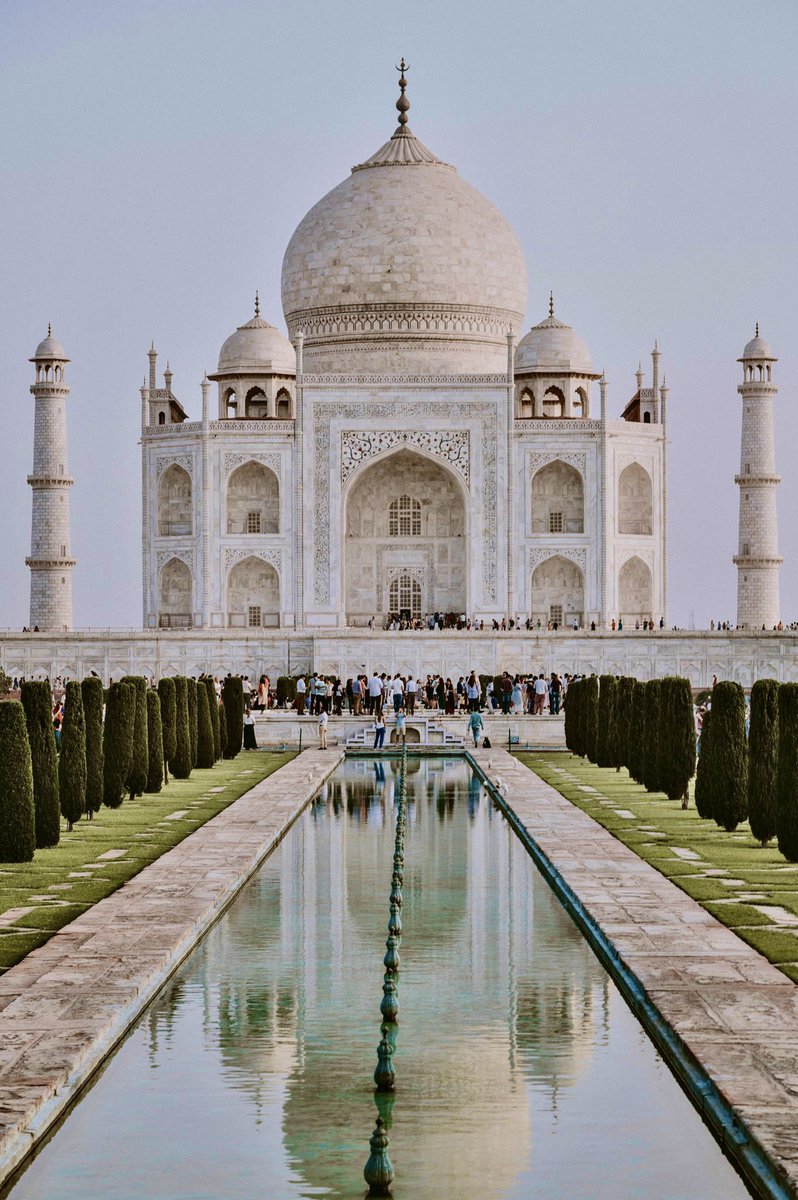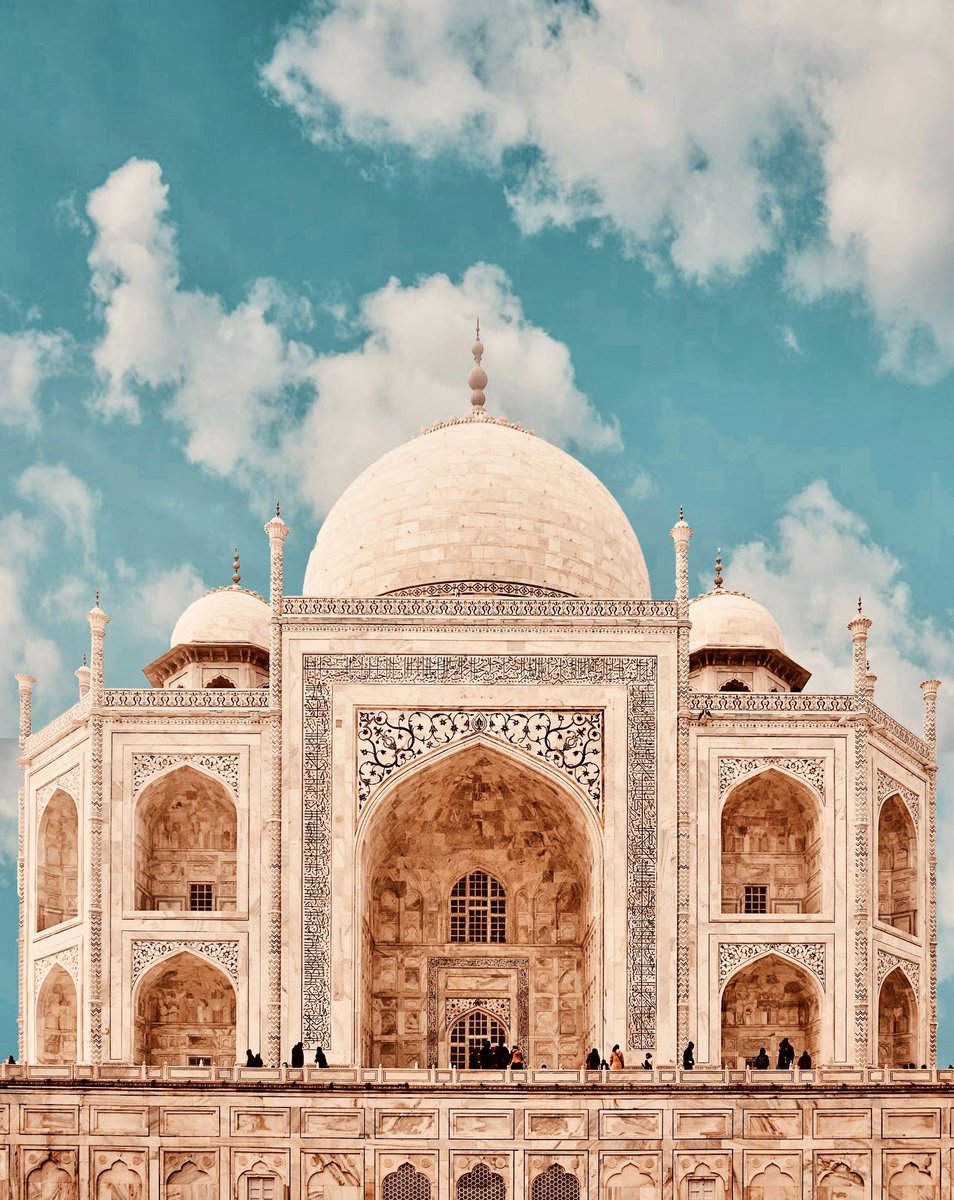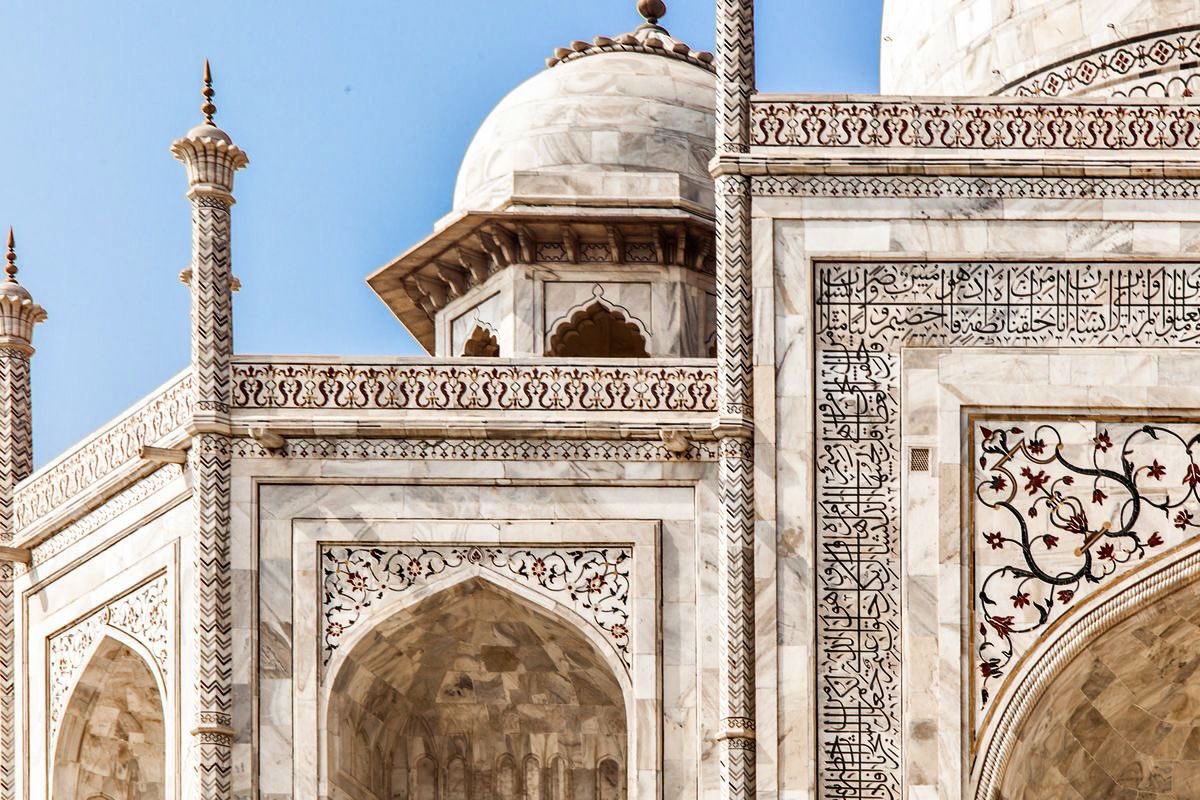
From Kazakhstan to Tajikistan, to Turkmenistan to Uzbekistan, Central Asia is known for its magnificent mosques – each an architectural masterpiece in their own right.
Here are 24 majestic mosques & examples of Islamic architecture across Central Asia #JummahMubarak
A thread…
Here are 24 majestic mosques & examples of Islamic architecture across Central Asia #JummahMubarak
A thread…

1/ Shah-i-Zinda, Uzbekistan
Ensemble includes mausoleums, mosques & other ritual buildings of 11-15th & 19th centuries. The name Shah-i-Zinda (meaning "The living king") is connected with the legend that Qutham ibn Abbas, a cousin of the Prophet Muhammad PBUH, is buried here
Ensemble includes mausoleums, mosques & other ritual buildings of 11-15th & 19th centuries. The name Shah-i-Zinda (meaning "The living king") is connected with the legend that Qutham ibn Abbas, a cousin of the Prophet Muhammad PBUH, is buried here

2/ Haji Yaqub Mosque, Dushanbe, Tajikistan
The central mosque of the capital of Tajikistan, the city of Dushanbe. It was named after Haji Yakub, a Tajik religious leader.
The mosque was founded 200 years ago and can accommodate up to 3,000 people
The central mosque of the capital of Tajikistan, the city of Dushanbe. It was named after Haji Yakub, a Tajik religious leader.
The mosque was founded 200 years ago and can accommodate up to 3,000 people

3/ Kalan Mosque, Bukhara, Uzbekistan
Initially commissioned by Arslan Khan in 1121, however, Genghis Khan destroyed the original Friday Mosque in 1220. The Kalan Mosque & Mir-i Arab Madrasah of today were commissioned in 1515 & 1535 by Shibani Kahn's nephew Ubaydullah Khan
Initially commissioned by Arslan Khan in 1121, however, Genghis Khan destroyed the original Friday Mosque in 1220. The Kalan Mosque & Mir-i Arab Madrasah of today were commissioned in 1515 & 1535 by Shibani Kahn's nephew Ubaydullah Khan

4/ Naryn Mosque, Kyrgyzstan
Built in 1995 by a local deputy. It is a central mosque of Naryn. The ornaments of the mosque are traditional nomadic embroideries called oymos. The blue color of the building also can indicate the shamanic background of Kyrgyz people
Built in 1995 by a local deputy. It is a central mosque of Naryn. The ornaments of the mosque are traditional nomadic embroideries called oymos. The blue color of the building also can indicate the shamanic background of Kyrgyz people

5/ Bibi Khanym Mosque, Uzbekistan
One of the most outstanding in the Islamic world. Built between 1399 & 1404 during the last years of the Turkic-Mongol conqueror, Timur, the Bibi Khanym mosque is riveting in its monumental scale, splendor & turquoise & blue tiles
One of the most outstanding in the Islamic world. Built between 1399 & 1404 during the last years of the Turkic-Mongol conqueror, Timur, the Bibi Khanym mosque is riveting in its monumental scale, splendor & turquoise & blue tiles

6/ Abdulatif Sultan Mosque, Istaravshan, Tajikistan
Also known as "Kok Gumbaz," which means "Blue Dome". Named after Abdullatif - son of the famous medieval philosopher and astronomer Ulugbekavym, on whose initiative was started construction
Also known as "Kok Gumbaz," which means "Blue Dome". Named after Abdullatif - son of the famous medieval philosopher and astronomer Ulugbekavym, on whose initiative was started construction

7/ Bishkek, Mosque of Imam Sarakhsi, Kyrgyzstan
This mosque, with help from Turkey, was opened in 2018 and has the classic Turkish mosque architecture. It has a capacity of 9,000 worshippers
This mosque, with help from Turkey, was opened in 2018 and has the classic Turkish mosque architecture. It has a capacity of 9,000 worshippers

8/ The Barak Khan Madrassa, Tashkent, Uzbekistan
The architectural complex was built in several stages, completed in 1532. It consists of a madrassa & two mausoleums attached to it. This religious educational establishment was named in honour of Tashkent ruler Navruz Ahmadkhan
The architectural complex was built in several stages, completed in 1532. It consists of a madrassa & two mausoleums attached to it. This religious educational establishment was named in honour of Tashkent ruler Navruz Ahmadkhan

9/ Gur-E-Amir Mausoleum, Samarkand, Uzbekistan
Persian for "Tomb of the King" contains the tombs of Tamerlane, his sons, grandsons & Timur's teacher. The earliest part of the complex was built at the end of the 14th century. Renowned for its blue & turquoise tiles
Persian for "Tomb of the King" contains the tombs of Tamerlane, his sons, grandsons & Timur's teacher. The earliest part of the complex was built at the end of the 14th century. Renowned for its blue & turquoise tiles

10/ Sher-Dor Madrasa, Samarkand, Uzbekistan
Built 1619-36, it stands opposite the Ulugh Beg Madrasa in Samarkand's Registan, a square. It was constructed by Yalangtush Bakhodur. He used a striking composition depicting two lions chasing deer
Built 1619-36, it stands opposite the Ulugh Beg Madrasa in Samarkand's Registan, a square. It was constructed by Yalangtush Bakhodur. He used a striking composition depicting two lions chasing deer

11/ The Mashkhur Jusup Mosque, Kazakhstan
Located in the center of Pavlodar. It was opened after a year of construction in 2001 and can accommodate 1,500 worshipers. The mosque was named after the Kazakh poet and historian Mashkhur Jusup
Located in the center of Pavlodar. It was opened after a year of construction in 2001 and can accommodate 1,500 worshipers. The mosque was named after the Kazakh poet and historian Mashkhur Jusup

12/ Khoja Ahror Valiy Mosque, Tashkent, Uzbekistan.
Also known as the Jama or Dzhuma Mosque, it was built in 1451 by Sheikh Ubaydullo Khoja Akhror (1404-1490)
Also known as the Jama or Dzhuma Mosque, it was built in 1451 by Sheikh Ubaydullo Khoja Akhror (1404-1490)

13/ Tilla Kari Madrasah, Samarkand, Uzbekistan
Built in the 17th century as the last, largest & most embellished structure of the famed Registan Square. It's name means ‘gold-covered', referring to the lavish decoration of its domed chamber. It is covered in blue tiles
Built in the 17th century as the last, largest & most embellished structure of the famed Registan Square. It's name means ‘gold-covered', referring to the lavish decoration of its domed chamber. It is covered in blue tiles

14/ Sulaiman-Too Mosque, Kyrgyzstan
One of the newest and the most notable ones around. The first thing that you would notice is that it is a huge building, the tallest in the area. It can accept up to 20 000 visitors
One of the newest and the most notable ones around. The first thing that you would notice is that it is a huge building, the tallest in the area. It can accept up to 20 000 visitors

15/ Hazrat Khizr Mosque, Samarkand, Uzbekistan
Constructed during 8th century it, is one of the oldest mosques in the country. It was built in the honour of Hazrat Khizr, one of the Muslim Saints, patron of travellers, who is responsible for water resources and wealth
Constructed during 8th century it, is one of the oldest mosques in the country. It was built in the honour of Hazrat Khizr, one of the Muslim Saints, patron of travellers, who is responsible for water resources and wealth

16/ Shah-i-Zinda, Uzbekistan
Ensemble includes mausoleums and other ritual buildings of 11-15th & 19th centuries. The name Shah-i-Zinda (meaning "The living king") is connected with the legend that Qutham ibn Abbas, a cousin of the Prophet Muhammad PBUH, is buried here (pic 2)
Ensemble includes mausoleums and other ritual buildings of 11-15th & 19th centuries. The name Shah-i-Zinda (meaning "The living king") is connected with the legend that Qutham ibn Abbas, a cousin of the Prophet Muhammad PBUH, is buried here (pic 2)

17/ Hazrat Sultan Mosque, Kazakhstan
The largest mosques in Kazakhstan was completed in summer 2012 with a maximum capacity of 10,000 worshippers
The largest mosques in Kazakhstan was completed in summer 2012 with a maximum capacity of 10,000 worshippers

18/ Bolo Haouz Mosque, Bukhara, Uzbekistan
Built in 1712, on the opposite side of the citadel of Ark in Registan district, it is inscribed in the UNESCO World Heritage Site list along with the other parts of the historic city. Details from the painted wooden roof
Built in 1712, on the opposite side of the citadel of Ark in Registan district, it is inscribed in the UNESCO World Heritage Site list along with the other parts of the historic city. Details from the painted wooden roof

19/ The new postmodern mosque in Astana, Kazakhstan.
It claims to be the only mosque in the world with a a positive balance of energy consumption. Giant solar batteries outside provide more than enough energy for the mosque with the rest going into the city's grid
It claims to be the only mosque in the world with a a positive balance of energy consumption. Giant solar batteries outside provide more than enough energy for the mosque with the rest going into the city's grid

20/ Ulugh Beg Madrasa, Samarkand, Uzbekistan
A UNESCO World Heritage Site, together with other monuments, it forms the monumental ensemble of Registan. It was built between 1417 & 1421 by the then-Timurid governor of Samarkand, Ulugh Beg, Timur's grandson & prominent astronomer
A UNESCO World Heritage Site, together with other monuments, it forms the monumental ensemble of Registan. It was built between 1417 & 1421 by the then-Timurid governor of Samarkand, Ulugh Beg, Timur's grandson & prominent astronomer

21/ Mosque, Zharkent, Kazakhstan
Built by a Chinese architect in 1886 using wood from local fir trees and is consturcted entirely without nails
Built by a Chinese architect in 1886 using wood from local fir trees and is consturcted entirely without nails

22/ Minor Mosque, Tashkent, Uzbekistan
Opened in 2014, it can accommodate more than 2,500 people.
Consists of a grand avenue planted with greenery & inside there is a large hall decorated with quotations from the Holy book of the Koran and a mark pointing to Mecca made of gold
Opened in 2014, it can accommodate more than 2,500 people.
Consists of a grand avenue planted with greenery & inside there is a large hall decorated with quotations from the Holy book of the Koran and a mark pointing to Mecca made of gold

23/ Shopan ata Underground Mosque, Mangystau, Kazakhstan
Carved inside a limestone hill, it became a mosque in the 10th century. Shopan ata is famous for his miraculous actions that happened during his life & after death, which attracts many pilgrims to to visit his necropolis
Carved inside a limestone hill, it became a mosque in the 10th century. Shopan ata is famous for his miraculous actions that happened during his life & after death, which attracts many pilgrims to to visit his necropolis

24/ Kalta Minor Minaret, Khiva, Uzbekistan
One of the last great blue buildings in the Khanate of Khiva was Kalta Minor. This had to be the tallest structure in Khiva & in the whole of Central Asia. Works ended abruptly in 1855, leaving this beautiful minaret unfinished
One of the last great blue buildings in the Khanate of Khiva was Kalta Minor. This had to be the tallest structure in Khiva & in the whole of Central Asia. Works ended abruptly in 1855, leaving this beautiful minaret unfinished

If you like this thread, check out our forthcoming Islamic Art & Culture Digital Festival, happening online - 28 & 29 November.
At the festival, a theme we will explore is Islamic Art & Sacred Spaces
Book your tickets: eventbrite.com/e/the-future-o…
At the festival, a theme we will explore is Islamic Art & Sacred Spaces
Book your tickets: eventbrite.com/e/the-future-o…

• • •
Missing some Tweet in this thread? You can try to
force a refresh

















